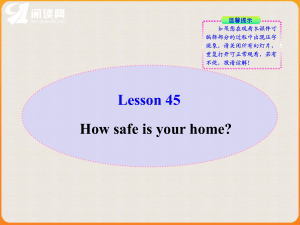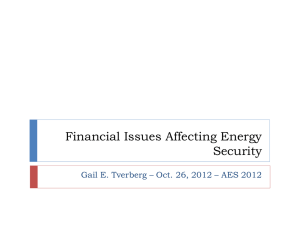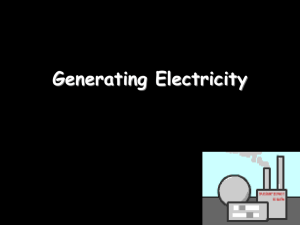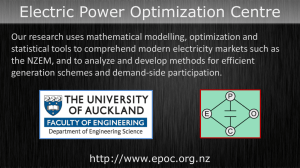The Enforcement of EU Competition Law in the energy
advertisement
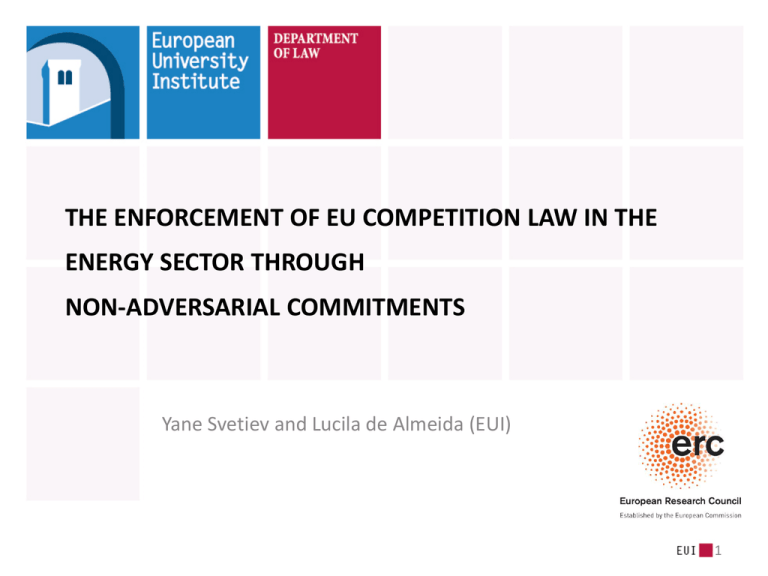
THE ENFORCEMENT OF EU COMPETITION LAW IN THE ENERGY SECTOR THROUGH NON-ADVERSARIAL COMMITMENTS Yane Svetiev and Lucila de Almeida (EUI) 1 Introduction and Structure 1. Role of Art. 9 Commitments in competition enforcement 2. Commitments Decisions in the Energy Sector 2.1. Tailoring Commitment Remedies 2.2. Accountability Mechanisms for Article 9 decisions 2 1. Commitment Decisions under the Article 9 • Non-adversarial case resolutions – Characterized as being among the most “high profile activities” of the EU Commission and – Also used by National Competition Authorities (NCAs); • Many cases in the energy sector decided through commitments procedure – Literature: Article 9 is most commonly used in energy sector and in cases involving intellectual property 3 1. Commitment Decisions under the Article 9 10 Commitment Decisions in the energy sector 2006 Repsol Oil COM 38.348 April 2006 2007 E.ON. Electricity COM 39.388 COM 39.389 November 2008 Distrigaz Gas COM 37.966 October 2007 2010 2009 2008 RWE Gas COM 39.402 March 2009 EDF Electricity COM 39.386 March 2010 SvK Electricity COM 39.351 April 2010 GDF Gas COM 39.316 December 2008 2012 ENI Gas COM 39.315 September 2010 E.ON. Gas COM 39.317 May 2010 Siemens/Areva Electricity COM 39.736 June 2012 4 1. Commitment Decisions under the Article 9 Research Questions • What are the reasons for the extensive use of non-adversarial procedures both by the Commission and by national authorities in the energy sector? – peculiar sectoral characteristics that make such a procedure particularly adapted to the energy context? • What are the distinguishing features of the use of nonadversarial procedures to restructure private relationships in the energy sector by the Commission? • What role do national actors play in this process and are they a check and source of accountability on the Commission’s interventions? 5 1. Commitment Decisions under the Article 9 Characterizing the Article 9 procedure 1. Settlements 1.1. Procedural: non-adversarial closure of cases 1.2. Substantive: clear-cut / non-serious cases 2. Tools of dynamic learning 2.1. Procedural: shift to monitoring 2.2. Substance: liability rules for an effects based policy 6 1. Commitment Decisions under the Article 9 1. It is difficult to argue that energy commitment decisions stem from cases in which the infringement is relatively clear based on extant community law. The majority of the cases based on abuse of dominance theory. 7 1. Commitment Decisions under the Article 9 Impugned conduct has involved 1.1. the manner in which a vertically-integrated company uses its own infrastructure or even its own capacity; Compa ny Economic Activity Impugned Conduct E.ON. Electricity generation and transmission system (i) withdraw available capacity in its transmission system and (ii) avoid third parties from making new investments in electricity generation RWE Gas Transmission system and supply market (i) refuse to supply gas transmission services to third parties and (ii) behavior aiming at lowering the margins of RWE's downstream competitors in gas supply (‘margin squeeze’) GDF Gas Transmission System and supply market Foreclose access to gas import capacities E.ON. Gas Transmission system Book large parts of the available firm and freely allocable entry capacities on its gas transmission grid ENI Gas transmission system Refuse to supply transportation capacity on its natural gas pipelines SvK Electricity generation and transmission system Anticipate internal congestion by reducing interconnection capacity for trade between Sweden and neighboring Member States 8 1. Commitment Decisions under the Article 9 Impugned conduct has involved also 1.2. the length of the contracts that energy supplier has concluded with its customers Company Economic Activity Impugned Conduct Distrigaz Gas Supply Market Limit the scope of long-term gas supply contractors for other gas suppliers concluding contracts with customers. EDF Electricity Supply Market Conclude supply contracts that limit the possibilities of other undertakings of concluding contracts for the supply of electricity to large industrial customers in France 9 1. Commitment Decisions under the Article 9 2. The commitments procedure is not limited to the cases that do not raise novel or disputes issues of law or its application to the facts (i.e. E.ON. Case) Comapny Econonomic Activity Commitment E.ON. Electricity generation and transmission system (i) Divest its shares on electricity generation, which sum the generation capacity of approximately 3.300 MW, (ii) divest its stakes on the transmission system business consisting of its 380/220 kV-line network . 10 1. Commitment Decisions under the Article 9 3. It cannot be said that the cases concluded pursuant to commitments in the energy sector are non-serious. Company Economic Activity Impugned Conduct E.ON. Electricity generation and transmission system (i) withdraw available capacity in its transmission system and; (ii) avoid third parties from making new investments in electricity generation. 11 1. Commitment Decisions under the Article 9 The substance of the cases often raises complex issues, requiring both weighing and trading off both arguments and likely effects. • The use of commitment decisions in the enforcement of EU competition law has been driven by the transformation of competition policy from a relatively blunt tool of economic integration towards a policy instrument increasingly sensitive to the effects of market conduct on policy relevant variables. 12 2. Commitment Decisions in Energy Sector 2.1. Types of Commitments and their tailoring Decisions that involve divestment capacity for generation or transmission of energy. Company Economic Activity Tailoring of Commitment E.ON. Electricity generation and transmission system (i) Divest its shares on electricity generation, which sum the generation capacity of approximately 3.300 MW, (ii) divest its stakes on the transmission system business consisting of its 380/220 kV-line network . RWE Gas Transmission system and supply market (i) Divest its entire current German high-pressure gas transmission system including networks co-owned with other parties, (ii) supply the purchaser for a limited period of up to five gas years. ENI Gas transmission system (i) Divest its current shareholdings in companies related to international gas transmission pipelines; (ii) Not prolong, renew or enter into any new transport contract to Italy for its benefit on these pipelines. 13 2. Commitment Decisions in Energy Sector 2.1. Types of Commitments and their tailoring Decisions that adopts more flexible approaches towards stimulating entry, by seeking to constrain autonomy and contract behaviour of investigated undertakings Company Economic Activity Tailoring of Commitment Distrigaz Gas Supply Market (i) Return to the market an average minimum of 70% of the gas volume supplied by Distrigaz to industrial users every year; (ii) restrict the term of its contracts with them to five years. GDF Gas Transmission System and supply market (i) Release 15% of the H gas consumption in whole France; (ii) release significant firm long-term capacities in two terminals; (iii) limit to less than 50% its long-term booking capacity in two balancing zones. EDF Electricity Supply Market (i) Return to the market 65% of the electricity supplied by EDF every year; (ii) sign contracts no longer than five years; (ii) customers would choose to obtain electricity from several suppliers. E.ON. Gas Transmission system (i) reduce its booking share in the available capacity in immediate and long-terms to 15-20% of capacities; (ii) reduce its booking share into the NCG and the L-gas grid to 50% and 64%. 14 2. Commitment Decisions in Energy Sector 2.1. Types of Commitments and their tailoring Decision that are less intrusive, in part reflecting differences in conduct and context investigated and in part different remedial commitments that parties were prepared to offer or agreed to. Company Economic Activity Tailoring of Commitment Siemens/A reva Electricity Generation (i) Reduce the effects of the non-compete clause from 11 years to 3 years in the joint venture Areva NP. 15 2. Commitment Decisions in Energy Sector 2.2. Accountability Mechanisms under Article 9 The review mechanisms are distinguished along two dimensions: • Timing of input • Source of review between judicial and peer input into the commitments proposed and adopted as part of an Art. 9 decision. 16 2. Commitment Decisions in Energy Sector Ex Ante Review: • Market Testing of the Commitments • ECN Advisory Committee (made-up of NCA representatives) Ex Post Review: • Reports provided either by the entities offered to the commitment or by external “trustees” involved in monitoring the implementation of the remedies. • Administrative or Private Law enforcement at the national level. 17 3. National Dimension as a source of accountability In the remainder of the paper, we aim to explore three principal arguments: • Characterize non-adversarial resolution practice of national competition authorities in energy sector; • Compare objectives pursued by national competition authorities in energy market through commitments with objectives of national energy regulators; • Understand the role that actions before national courts play in overall mix of interventions 18 Thank you! Yane.Svetiev@eui.eu Lucila.DeAlmeida@eui.eu 19


